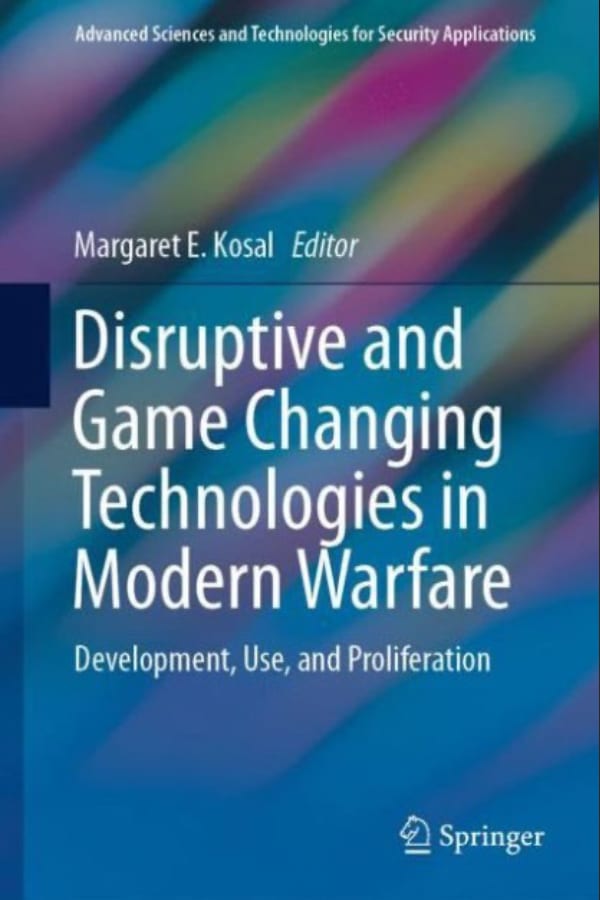ISBN 978-3-03028-341-4, Springer International Publishing, September 2019, 222 pages, $139.99 hardcover
Reviewed by: Darrin L. Frye, Naval Medical Research Unit, San Antonio, Texas, USA
In this formative work, Disruptive and Game-Changing Technologies in Modern Warfare, the authors skillfully dissect modern warfare’s intricate and ever-evolving landscape. Focused on three pivotal themes—Adoption, Proliferation, and Governance of disruptive technology; challenges to strategic stability posed by disruptive technologies; and the effects of these innovations on military capabilities and operations—the book emerges as a comprehensive guide to the complex intersection of technology and warfare.
The journey begins with a meticulously crafted introduction that captures the reader’s attention and lays the groundwork for an engaging exploration of the subsequent ten chapters. Each chapter delves into a specific technological domain, presenting an in-depth analysis that seamlessly weaves together relevant context, relatable content, and insightful references. Each chapter is well-structured and can be used independently as a self-contained, detailed study or as part of a broader exploration of game-changing technologies.
The metaphorical three-legged stool, comprised of Adoption, Proliferation, and Governance, serves as a framework for understanding the successful integration of game-changing innovations into the competitive battlespace. The authors underscore the critical importance of each leg, emphasizing their collective contribution to ensuring the efficacy of these innovations.
Particularly noteworthy are the chapters focused on Adoption, Proliferation, and Governance. The discussion on Revolutions in Military Affairs transcends mere technological details, offering a thoughtful reflection on the current technologies supporting military systems. The authors delve into the sobering methodology of predicting technology proliferation, exposing the futility of banning specific weaponry while shedding light on the challenges posed by lethal autonomous weapons.
The examination of emerging life science technologies introduces the intriguing “dual-use conundrum,” urging serious discussion on the ramifications of precision genomic editing and targeting provided by CRISPR-Cas9 systems technology. With this remarkable DNA-targeting tool and other emerging biological technologies, the potential realm of violent possibilities increases exponentially, demanding enhanced analysis of novel threats that were formerly improbable.
In a subsequent chapter, the authors highlight the emergence of novel metamaterials and their critically important enabling contributions and capabilities. They introduce discussions on enhanced compositions that boost strength and communication while expanding capabilities such as speed of action, increased stealth, and sustainability. These dynamic physical innovations can now be created with precision manufacturing through 3D (additive manufacturing) printing. Beyond the intricate designs, manufacturing specifications, and frequent layering of discordant material requirements, the completion of functional tools at or beyond the visible scale remains a remarkable achievement. These industrial technologies present fantastic opportunities but also formidable challenges for the global community seeking to control the spread of weaponizable technologies.
Leaders in the modern era continue to govern indomitably despite the psychological weight and physical threat posed by vast nuclear weapon arsenals strategically buried around the world. The authors provide an excellent discussion on how emerging technologies, such as Artificial Intelligence and Machine Learning (ML), could assist in tracking nuclear progress, identifying potential inflection points, and establishing best practices for deterrence. The application of advancing predictive tools like ML to counter Weapons of Mass Destruction threats—including both biological and nuclear systems—adds thoughtful depth and relevance to the exploration of disruptive technologies.
Addressing the weaponization of energy, the authors introduce an interesting discriminatory methodology emphasizing the necessity of distinguishing between targeting machinery and personnel. This distinction is essential and is well captured in discussions on the powerful capabilities of energy-based weapons, the range of available options, and—most importantly—their ethical implications. The detailed breakdown of passive, active, conventional, and directed energy forms driving electromagnetic (EM) weapons provides further insight into this relatively unknown but highly influential emerging armament.
Just as critical as the energy driving battlespace weaponry is the massive amount of incoming energy required to power all systems. From complex command and control networks to vehicle coordination and soldier-carried devices, power is essential for maintaining battlefield advantage. The discussion on rapidly recharging destructive devices and the energy demands of battlespace operations offers a holistic perspective on the intricate interplay between technology, innovation, and strategic options.
The strategic view from the air, particularly in the context of protecting Army Aviation and enabling military dominance, becomes paramount in facing challenges posed by both state and non-state actors. As the authors emphasize, “Without air superiority, there is no asymmetric strategic advantage ensuring global freedom of maneuver for land (or other) forces.”
Appropriately positioned, the final chapter on logistics underscores the importance of supply as a prerequisite for the success of forces at all levels, particularly for sustained operations. It adeptly connects emerging technologies discussed earlier in the book to paradigm shifts in support, adaptability, control, sustainability, and their impact on future logistical operations.
The sheer amount of detail and the vast scope of the narratives could be overwhelming; however, the chapters are expertly written so that readers of all backgrounds can easily relate to and understand the overarching concepts. While technology-dense books always demand a certain level of attention and patience from the reader, the effort is undoubtedly rewarding.
Congratulations to the authors for successfully navigating the rapid pace of innovation and presenting such a comprehensive and engaging discussion of disruptive and game-changing technologies. This book caters to a diverse audience, from technology enthusiasts tracking emerging advancements to strategic planners and civilian and military professionals seeking a nuanced understanding of innovative science and its implications for security forces. Because of this, Disruptive and Game-Changing Technologies in Modern Warfare is an indispensable guide for anyone invested in the evolving landscape of modern warfare.
Darrin Frye is the Chief Science Director at Naval Medical Research Unit San Antonio (NAMRU-SA). Previously, he was an Associate Professor at the Joint Special Operations University (JSOU), specializing in Science and Technology and Innovative Futures at USSOCOM.








